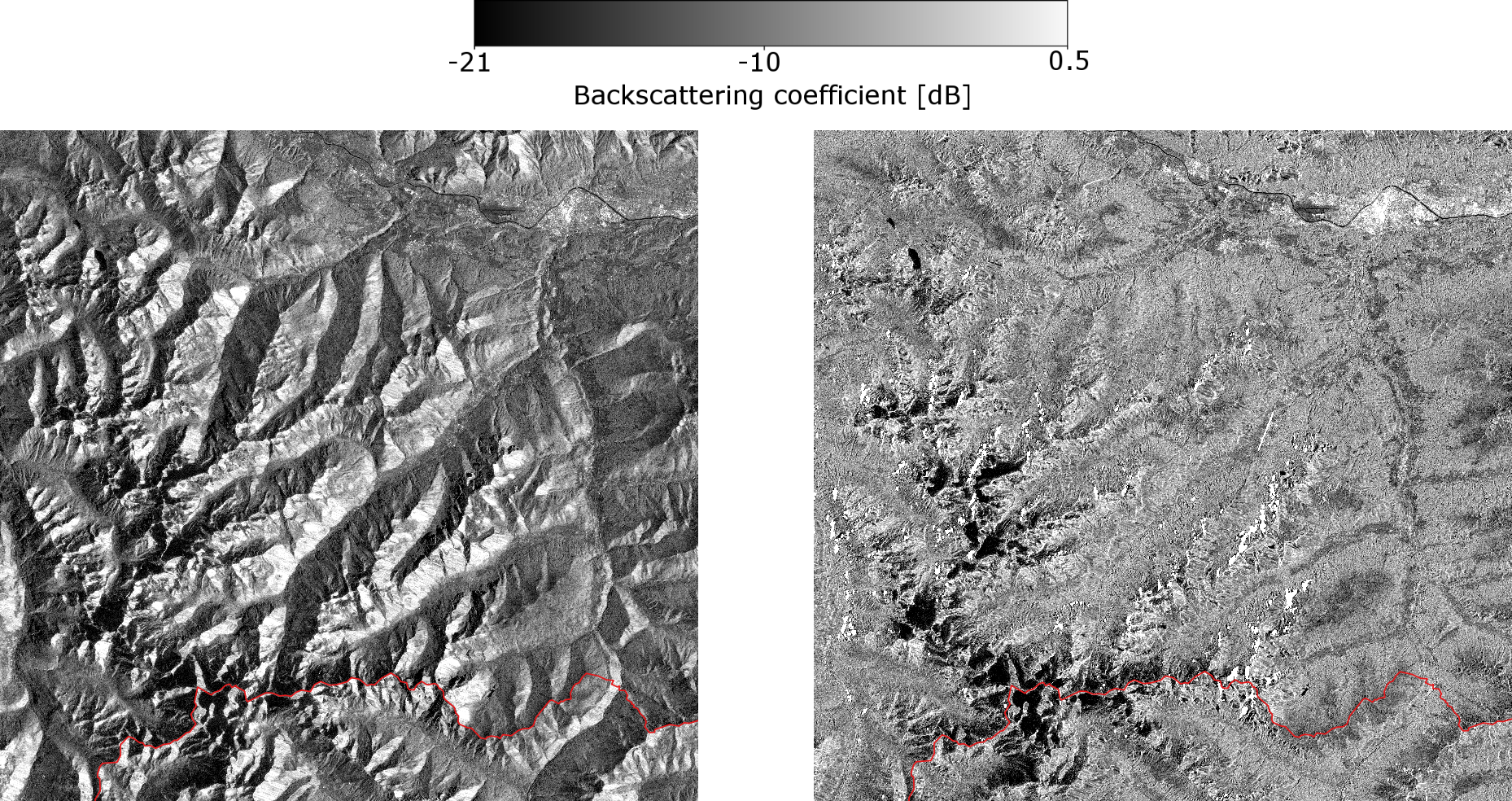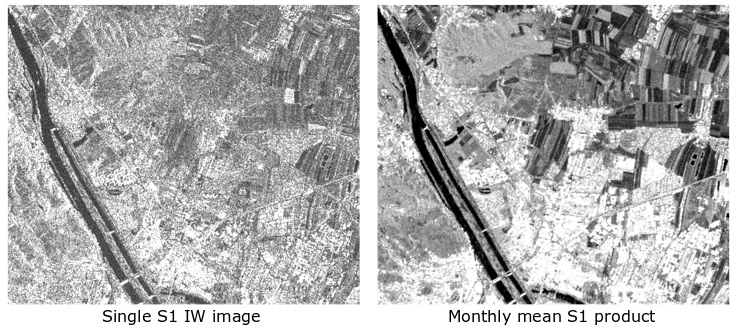3.5.3. Sentinel-1 products overview
Index
- Processing chain
- Preprocessing
- Parameters
- Products
- Examples
- SIG0 and GMR comparison
- Monthly mean (MMEN)
- Surface soil moisture (SSM)
- Seasonal RGB composite (S-COMP)
- References
Processing chainThe SAR Geophysical Retrieval Toolbox (SGRT)1 allows to use Sentinel-1A and Sentinel-1B raw data (Level 1, SAFE format) as an input and produce higher level products, such as preprocessed- (Level 2), parameter- and value-added product datasets (Level 3-4) (the naming convention follows the SGRT terminology). SGRT is developed within the microwave remote sensing research group at the Geo Department of TU Wien. PreprocessingThe preprocessed data is derived from the Sentinel-1 raw files with the assistance of the Sentinel Application Platform (SNAP). The Interferometric Wide swath mode (IW) (cf. acquisition modes) is mainly used for monitoring land surfaces and therefore serves as the most used mode for preprocessing Sentinel-1 data at TU Wien. One raw/SAFE file (i.e. a folder) contains two images for both VV and VH polarisation and metadata being important for further processing steps. These images are available in swath/sensor geometry, which means that the coordinate system is bound to the sensor (azimuth and range), not to Earth (e.g. longitude and latitude). The following steps are necessary to transform this raw data into a reliable representation of backscatter and
After this routine, and depending on the specified settings, the following Level-2 products can be retrieved: SIG0:SIG0 represents the backscatter returned from a unit area on the ground. It is available in VV and VH polarisation. GMR:GMR represents the radiometric terrain flattened backscatter returned from a unit area perpendicular to the looking direction. Radiometric terrain flattening takes care of and departs overlapping pulses (layover and foreshortening) resulting from the side-looking acquisition. Thus, this product is the one having the least impact of terrain variations on backscatter at an expense of higher processing capacities and a larger time of computation needed (cf 2 for further details). It is available in VV and VH polarisation. PLIA:PLIA is the abbreviation for Projected Local Incidence Angle, which is defined as the angle between the surface normal and the satellite (also known as Local Incidence Angle (LIA)) projected into the range plane. The surface normal is either defined by the ellipsoid normal (simplified Earth model) or the local neighbourhood of heights given by a DEM. Thus, for one Sentinel-1A/B acquisition (i.e. for one point in time) two SIG0 images (VV and VH), two GMR images (VV and VH) and one PLIA image are available. ProductsSGRT products are derived based on single (i.e. one timestamp) or aggregated (over a specific timespan) preprocessed data. It has to be noted, that the radiometric terrain flattened GMR is a relatively new representation of backscatter and is therefore kept at the preprocessing level at the moment. A list of higher-level products is given below:
ParametersParameter products build upon a timestack of preprocessed (SIG0, GMR, PLIA) data or other higher-level data products (WWS, SSM) and aim to aggregate a product over time using different statistics. One can specify the temporal interval of aggregation:
For a detailed description of the product naming convention and concatenation of the herein presented parts see ..... Available statistical measures are given below:
Examples
Surface soil moisture (SSM)
Sentinel-1 SSM product at 500m spatial sampling over Austria. The depicted acquisition ranges from 02.08.2016 to 10.08.2016. One can identify dry regions in the eastern part and wet regions in the center part. Water bodies, mountains and cities are depicted as white, since a soil moisture retrieval can not be performed for this types of land cover (at the moment). Additionally, forest regions also do not yield a reliable estimate of soil moisture, but have not been masked out due to the lack of a forest mask. Seasonal composite (S-COMP)
Left: Landsat-8 RGB image of London area, UK. Middle: False colour composite (RGB) of Sentinel-1 backscatter data over London area, UK. Red band shows mean of backscatter (VH) during summer (Jun-Jul-Aug), Blue band shows mean of backscatter (VH) during winter (Dec-Jan-Feb), and Green band shows the ratio of the Red and Blue band (mean_summer/mean_winter). Right: False colour composite (RGB) of Sentinel-1 backscatter data over London area, UK. Red band shows mean of backscatter (VV) during winter (Dec-Jan-Feb), Blue band shows mean of backscatter (VH) during winter (Dec-Jan-Feb), and Green band shows the ratio of the Red and Blue band (mean_summer/mean_winter). This composite highlights the variation of backscatter due to different polarizations. (data composites) | |
References | |
1 Naeimi, Vahid et al. (2016). “Geophysical parameters retrieval from sentinel-1 SAR data: a case study for high performance computing at EODC”. In: Proceedings of the 24th High Performance Computing Symposium. Society for Computer Simulation International, p. 10. 2 Small, David (2011). "Flattening gamma: Radiometric terrain correction for SAR imagery". In: IEEE Transactions on Geoscience and Remote Sensing 49.8, pp. 3081-3093. 3Gruber, Alexander et al. (2013). “Potential of Sentinel-1 for high-resolution soil moisture monitoring”. In: Geoscience and Remote Sensing Symposium (IGARSS), 2013 IEEE International. IEEE, pp. 4030–4033. |



